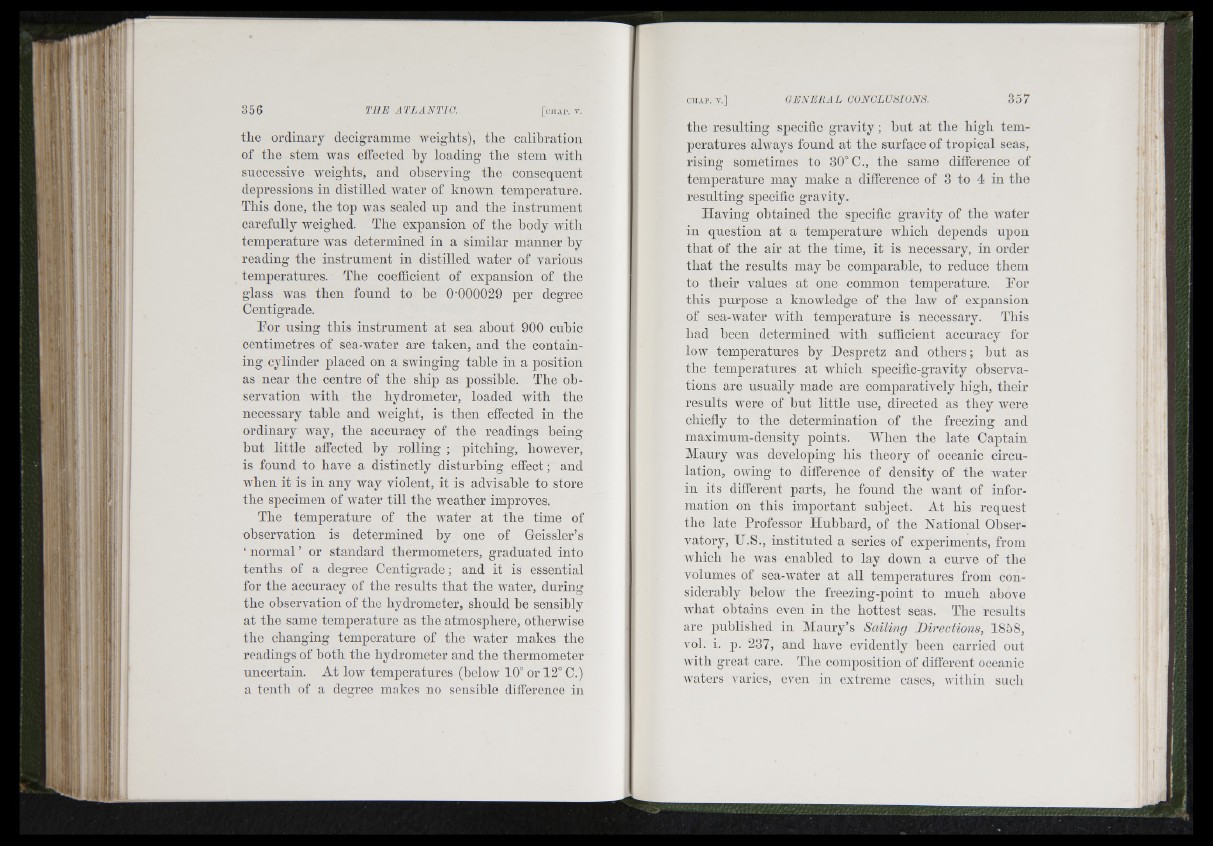
the ordinary decigramme weights), the calibration
of tbe stem was effected by loading tbe stem with
successive weights, and observing the consequent
depressions in distilled Avater of knoAA'n temperature.
This done, the top was sealed np and the instrument
carefully Aveighed. The expansion of the hody Avith
temperature AA'as determined in a similar manner hy
reading the instrument in distilled water of various
temperatures. The coefficient of expansion of the
glass was then found to be 0-000029 per degree
Centigrade.
Eor using this instrument at sea ahout 900 cubic
centimetres of sea-water are taken, and the containing
cylinder placed on a sAvinging tahle in a position
as near the centre of the ship as possible. The observation
Avith the hydrometer, loaded with the
necessary tahle and Aveight, is then effected in the
ordinary Avay, the accuracy of the readings heing
but little affected hy rolling ; pitching, hoAvever,
is found to have a distinctly disturbing effect ; and
Avhen it is in any way violent, it is advisable to store
the specimen of Avater till the Aveather improves.
The temperature of the water at th e time of
observation is determined hy one of Geissler’s
‘ normal ’ or standard thermometers, graduated into
tenths of a degree Centigrade; and it is essential
for the accuracy of the results th a t the water, during
the observation of the hydrometer, should be sensibly
at the same temperature as the atmosphere, otherwise
the changing temperature of the Avater makes the
readings of both the hydrometer and the thermometer
uncertain. At I oav temperatures (beloAV 10° or 12° C.)
a tenth of a degree makes no sensible difference in
the resulting specific gravity ; hut at the high temperatures
alAA'ays found at the surface of tropical seas,
rising sometimes to 30° C., the same difference of
temperature may make a difference of 3 to 4 in the
resulting specific gravity.
Having obtained the specific gravity of the water
in question at a temperature which depends upon
th a t of the air at the time, it is necessary, in order
th a t the results may he comparahle, to reduce them
to their values at one common temperature. Eor
this purpose a knowledge of the law of expansion
of sea-Avater AA'ith temperature is necessary. This
had heen determined Avith sufficient accuracy for
loAV temperatures by Despretz and others ; b u t as
the temperatures at which specific-gravity observations
are usually made are comparatively high, their
results were of but little use, directed as they were
chiefly to the determination of the freezing and
maximum-density points. MTien the late Captain
Maury was developing his theory of oceanic circulation,
OAving to difference of density of the Avater
in its different parts, he found the want of information
on this important subject. At his request
the late Professor Hubbard, of the National Observatory,
U.S., instituted a series of experiments, from
Avhich he Avas enabled to lay doAvn a curve of the
volumes of sea-Avater at all temperatures from considerably
helow the freezing-point to much ahove
what obtains even in the hottest seas. The results
are published in Maury’s Sailing Directions, 1858,
vol. i. p. 237, and have evidently heen carried out
Avith great care. Tlie composition of different oceanic
AA'aters varies, even in extreme cases, AA'ithin such
ir
i i